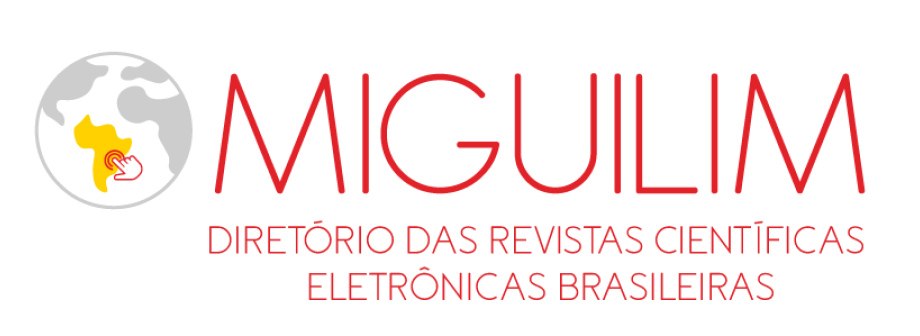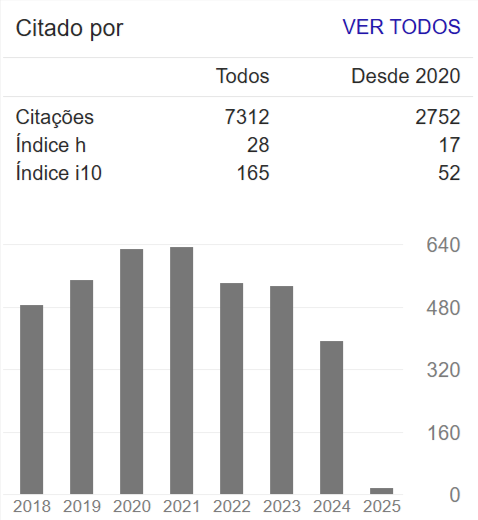Monitoring of pesticides in water supply systems
a comparative analysis between Ordinance no. 888/2021 and International Directives
Abstract
The presence of pesticides in water for human consumption is a growing concern in Brazil and worldwide. Surveillance and control procedures are necessary to guarantee drinking water free of traces of pesticides. Most developed countries regularly control the main pesticides. International guidelines design monitoring plans by assessing whether the pesticides were already detected in water, what is the environmental behavior of the active ingredients, and what are the risks associated with human health and the environment. The frequency adopted according to these criteria is not uniform for the different compounds. In Brazil, Ordinance No. 888/2021 defines a six-monthly frequency for 40 pesticides applied to all water supply systems. Meeting this demand is complex considering the precarious logistics and lack of resources in some Brazilian regions. It is up to the health surveillance of the municipalities to evaluate the operators' monitoring plans, which can be hampered by the lack of infrastructure and of trained personnel. In view of the issues addressed, this article compares the requirements of international practices with those of Ordinance No. 888/21 for the monitoring of pesticides, highlighting the need to establish procedures that optimize the necessary actions in the preparation of monitoring plans.
References
ANA. Agência Nacional de Águas e Saneamento Básico. Panorama do enquadramento dos corpos d’água do Brasil, e, Panorama da qualidade das águas subterrâneas no Brasil. Brasília: ANA, 2007. 124 p. il. (Caderno de Recursos Hídricos, 5) ISBN: 978-85-89629-29-4.
ANA. Agência Nacional de Águas e Saneamento Básico. Qualiágua.
Disponível em: http://pnqa.ana.gov.br/Qualiagua.aspx. Acesso em: 16 jun.2022.
ANA. Agência Nacional de Águas e Saneamento Básico. Atlas águas: segurança hídrica do abastecimento urbano. – Brasília: ANA, 2021. 332 p.: il. Disponível em: https://portal1.snirh.gov.br/ana/apps/storymaps/stories/1d27ae7adb7f4baeb224d5893cc21730. Acesso em: 24 Jan. 2023.
ANZECC (Australia and New Zealand Environment and Conservation Council) and ARMCANZ (Agriculture and Resource Management Council of Australia and New Zealand) (2000). Australian Guidelines for Monitoring and Reporting. National Water Quality Management Strategy Paper No. 7, ANZECC and ARMCANZ, Canberra.
ARAÚJO, I. M. M., OLIVEIRA, A. G. R. C. Agronegócio e agrotóxicos: Impactos à saúde dos trabalhadores agrícolas do nordeste brasileiro. Revista Trabalho, Educação e Saúde. Rio de Janeiro, v. 15, n. 1, p. 117-129. jan./abr. 2017.
BOMBARDI, L. M. Geografia do Uso de Agrotóxicos no Brasil e Conexões com a União Europeia. São Paulo: FFLCH - USP, 2017. 296 p. ISBN:978-85-7506-310-1. Disponível em: https://conexaoagua.mpf.mp.br/arquivos/agrotoxicos/05-larissa-bombardi-atlas-agrotoxico-2017.pdf. Acesso em: 20 jul. 2023.
BRASIL. Instituto Nacional de Metrologia, Qualidade e Tecnologia – INMETRO. Laboratórios. 2022. Disponível em: http://www.inmetro.gov.br/laboratorios/rbc/. Acesso em: 02 jul. 2022.
BRASIL. Ministério da Saúde. Revisão do Anexo XX da Portaria de Consolidação nº 5 de 28 de setembro de 2017 do Ministério da Saúde. Critérios de seleção de agrotóxicos. 2020. Disponível em: https://www.gov.br/saude/pt-br/acesso-a-informacao/participacao-social/consultas-publicas/2020/arquivos/DOCSNTESEAGROTXICOS1METODOLOGIADESELEO.pdf. Acesso em: 14 ago. 2023.
BRASIL. Ministério da Saúde. Portaria nº 888/2021 da Vigilância e Qualidade da Água. 2021. Disponível em: https://www.in.gov.br/en/web/dou/-/portaria-gm/ms-n-888-de-4-de-maio-de-2021-318461562. Acesso em: 20 set. 2021.
BRASIL. Ministério da Saúde. Secretaria de Vigilância em Saúde. Departamento de Vigilância em Saúde Ambiental e Saúde do Trabalhador. Diretriz Nacional do Plano de Amostragem da Vigilância da Qualidade da Água para Consumo Humano. Brasília: Ministério da Saúde, 2016. Disponível em: https://bvsms.saude.gov.br/bvs/publicacoes/diretriz_nacional_plano_amostragem_agua.pdf. Acesso em: 12 mar. 2022.
CHILTON, J. Groundwater. In: CHAPMAN, D. (Ed.) Water quality assessments: A guide to the use of biota, sediments and water in environmental monitoring. 2nd. ed. London: WHO/Spon, 1996.
CORREIA, N. M. Comportamento dos herbicidas no ambiente. Brasília, DF: Embrapa Hortaliças, 2018. 30 p.: il. color. ; 21 cm x 27 cm. (Documentos / Embrapa Hortaliças, ISSN 1415-2312; 160).
CPRM. Serviço Geológico do Brasil. Rede Integrada de Monitoramento das Águas Subterrâneas. 2023. Disponível em: https://rimasweb.sgb.gov.br/layout/?_gl=1*md0qev*_ga*ODcxOTQwMDMyLjE2OTAwNTU5MjM.*_ga_HYCRRWGXHJ*MTY5MTk4MjU5Ny43LjEuMTY5MTk4MjYxMC4wLjAuMA. Acesso em: 10 ago. 2023.
CRITTEDEN, J. C.; TRUSSELL, R. R.; HAND, D. W; HOWE, .J.; TCHOBANOUGLOUS, G. Stantec´s Water Treatment: principles and Design. 3rd ed. Hoboen, N.J.: Wiley, 2022.
DEPARTMENT of Environmental Health Public Health Services. Ministry of Health State of Israel. Public Health Regulations 2013 The Sanitary Quality of Drinking Water and Drinking Water Facilities. Records collection of regulations. Nº 7262. June 26, 2013. Disponível em: https://www.health.gov.il/Subjects/Environmental_Health/drinking_water/Documents/Briut47-Eng.pdf. Acesso em: 25 abr. 2022.
DIRETIVA (UE) 2020/2184 do Parlamento Europeu e do Conselho, de 16 de dezembro de 2020, sobre a qualidade da água destinada ao consumo humano (reformulação). Disponível em: https://eur-lex.europa.eu/legal-content/PT/TXT/?uri=CELEX:32020L2184. Acesso em: 13 ago. 2022.
EMBRAPA. Empresa Brasileira de Pesquisa Agropecuária, 2020. Disponível em: https://www.agencia.cnptia.embrapa.br/gestor/agricultura_e_meio_ambiente/arvore/CONTAG01_39_210200792814.html. Acesso em 15/Ago./2021
ENVIRONMENTAL PROTECTION AGENCY. EPA Human Health Issues Related to Pesticides. 2022. Disponível em: https://www.epa.gov/pesticide-science-and-assessing-pesticide-risks/human-health-issues-related-pesticides. Acesso em: 4 abr. 2022.
FAO. Food and Agriculture Organization of the United Nations. Pesticides Use. 2023. Emprego mundial de agrotóxicos. Disponível em: https://www.fao.org/faostat/en/#data/RP. Acesso em: 14 ago. 2023.
GEBLER, L., SPADOTTO, C. A. Comportamento ambiental dos herbicidas. Manual de manejo e controle de plantas daninhas. EMBRAPA. 2008. Disponível em: https://edisciplinas.usp.br/pluginfile.php/4456155/mod_resource/content/1/Gebler%20e%20Spadotto%20%282008%29.pdf. Acesso em: 26 jun. 2022.
GILLIOM, R. J. Pesticides in U.S. streams and ground water. Environ Sci Technol 41, 3408–3414 (2007). Disponível em: https://pubs.acs.org/doi/pdf/10.1021/es072531u Acesso em: 07 ago. 2023.
GRÜTZMACHER, D. D. et al. Monitoramento de agrotóxicos em dois mananciais hídricos no sul do Brasil, 2008. Disponível em: https://www.scielo.br/j/rbeaa/a/T3mRPxxGYmmXv6LgQVJbxkf/?lang=pt#. Acesso em: 31 jul. 2023.
HANSON, B.; BOND, C.; BUHL, K.; STONE, D. (2015). Pesticide Half-life Fact Sheet; National Pesticide Information Center, Oregon State University Extension Services. Disponível em: http://npic.orst.edu/factsheets/half-life.html. Acesso em: 27 Out. 2022.
IBAMA. Instituto Brasileiro do Meio Ambiente e dos Recursos Naturais. Relatórios de comercialização de agrotóxicos. 2020. Disponível em: https://www.ibama.gov.br/index.php?option=com_content&view=article&id=594&Itemid=5. Acesso em: 18 Fev. 2021.
IBAMA. Instituto Brasileiro do Meio Ambiente e dos Recursos Naturais. Relatórios de comercialização de agrotóxicos, 2023. Disponível em: https://www.ibama.gov.br/index.php?option=com_content&view=article&id=594&Itemid=5. Acesso em: 28 jul.2023.
IBGE. Instituto de Brasileiro de Geografia e Estatística. Pesquisa Nacional de Saneamento Básico, 2017. Disponível em: https://www.ibge.gov.br/estatisticas/multidominio/meio-ambiente/9073-pesquisa-nacional-de-saneamento-basico.html?edicao=28244&t=destaques. Acesso em: 12 mar. 2022.
LEWIS, S. E.; SILBURN, D. M.; KOOKANA, R. S.; SHAW, M. 2016. Pesticide Behavior, Fate, and Effects in the Tropics: An Overview of the Current State of Knowledge. Journal of Agricultural and Food Chemistry, v. 64, n. 20, p. 3917-3924.
LOFRANO, G., LIBRALATO, G., MERIC, S., VAIANO, V., SACCO, O., VENDITTO, V., GUIDA, M., CAROTENUTO, M., 2020. 1 – Occurrence and potential risks of emerging contaminants in water. In: SACCO, O., VAIANO, V. (Eds.), Visible Light Active Structured Photo catalysis for the Removal of Emerging Contaminants. Elsevier, p. 1–25.
LOPES, C. V. A.; ALBUQUERQUE, S. C. A. Agrotóxicos e seus impactos na saúde humana e ambiental: uma revisão sistemática. Revisão. Saúde debate, v. 42, n. 117, . Apr./Jun. 2018. https://doi.org/10.1590/0103-1104201811714
LUCAS, E. de O. et al. Contaminação dos recursos hídricos por agrotóxicos na região central do Rio Grande do Sul, Brasil, 2020. Disponível em: https://rsdjournal.org/index.php/rsd/article/download/7128/6435/106611. Acesso em: 31 jul. 2023.
NRMMC. Australian Drinking Water Guidelines Paper 6 National Water Quality Management Strategy. National Health and Medical Research Council, National Resource Management Ministerial Council, Commonwealth of Australia, Canberra, 2022.
SIAGAS. Sistema de Informações de Águas Subterrâneas. Disponível em: https://siagasweb.sgb.gov.br/layout/?_gl=1*19zekek*_ga*ODcxOTQwMDMyLjE2OTAwNTU5MjM.*_ga_HYCRRWGXHJ*MTY5MTAwOTcxOC41LjEuMTY5MTAxMDI4Ni4wLjAuMA. Acesso em: 10 ago. 2023.
SISÁGUA. Percentual de atendimento da diretriz nacional da vigilância. 2023. Disponível em: https://sisagua.saude.gov.br/sisagua/login.jsf. Acesso em: 12 fev. 2023.
SISÁGUA. Sistema de Informação de Vigilância da Qualidade da Água para Consumo Humano. 2022. Disponível em: https://sisagua.saude.gov.br/sisagua/login.jsf. Acesso em: 12 fev. 2023.
STEHLE, S., SCHULZ, R. Agricultural insecticides threaten surface waters at the global scale. Proceedings of the National Academy of Sciences, v. 112, n. 18, p. 5750-5755, 2015. http://www.pnas.org/content/112/18/5750.full.pdf.
TEODOSIU, C., GICA, A. F., BARJOVEANU, G., FIORE, S. Emerging pollutants removl through advanced drinking water treatment: A review on processes and environmental performances assessment, Journal of Cleaner Production, v. 197, Part. 1, p. 1210-1221, 2018. https://doi.org/10.1016/j.jclepro.2018.06.247. Disponível em: https://www.sciencedirect.com/science/article/pii/S0959652618319061. Acesso em: 16 jun. 2022.
WHO - WORLD HEALTH ORGANIZATION. Guidelines for drinking-water quality: fourth edition incorporating the first addendum. Geneva: WHO, 2022. Disponível em: www.who.int/water_sanitation_health/publications/drinking-water-quality-guidelines-4-including -1st-addendum/en/. Acesso em: 10 fev. 2023.

















